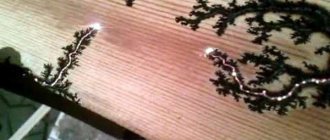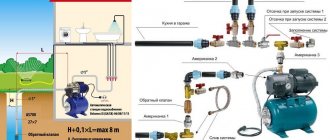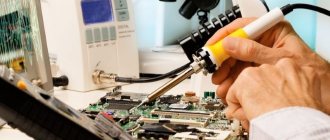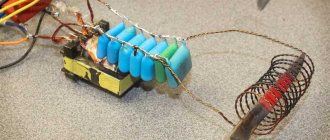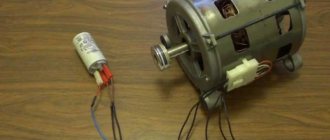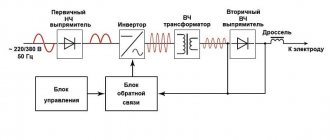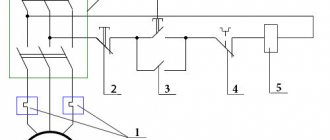The reversing switch is a manual switch. It is necessary to switch the power supply to the house's electrical wiring from the city line to the generator.
In contrast to the automatic switching on of the reserve - ATS, with the help of a reversible (changeover) switch, the reserve is manually switched on. That is, if there is no voltage in the city line, you must manually start the generator and switch it; when voltage appears in the city line, you must manually switch to the city line and turn off the generator.
The peculiarity of changeover switches is that switching occurs with an open circuit; they have three positions: I – 0 – II, or: city line – 0 – generator.
Today, to manually switch on the reserve of a private home, reversible (changeover, modular) switches from ABB are almost always used.
For electrical installation in private homes, two types are sufficient: ABB OT63F3C and ABB OT40F3C, respectively for 63A and 40A.
As an example, a connection diagram is shown for a three-phase house wiring diagram and a single-phase generator.
These devices are produced for three-phase networks, but they can also be used in single-phase electrical wiring circuits without any problems.
The ABB reversing switch is modular, it is a compact, modern and reliable device. Installation is possible in any panel on a DIN rail.
In dacha areas, garden plots, the private sector and similar places, frequent power outages are common. Here they can turn off the lights for an hour, for the whole day or for a longer time. This creates quite a few problems, since people can no longer imagine life without electricity. He has things working at home: a refrigerator, a TV, room lighting, a pump for watering the garden, and the like.
Gasoline power plants are very popular in such places. Turn off the lights, start the gas generator and continue to enjoy life. The power plant must be connected to the distribution board through a special outlet. Below I look at the diagram of a distribution board with a “mains-generator” switch, which allows you to switch to power supply from a gas generator when the external network is lost and back.
Here I am considering manual switching, which is carried out using a reversing switch. All diagrams show an ABB OT40F3C switch. This is a high-quality and reliable reversible switch. It has three positions:
- the handle is turned to the left - the contacts on its left side are closed, and on the right side they are open;
- the handle is in a vertical position - all contacts are open (both right and left);
- the handle is turned to the right - the contacts on its right side are closed, and on the left side they are open.
If what is written is not entirely clear, then look at the latest diagram and you will immediately understand how it works.
It is worth noting that if you take such a reversing switch for a higher current, then the switch handle is not included in the kit. It must be purchased separately.
Below is a simple single-phase switchboard diagram with a mains-generator switch. This is plenty for a small dacha or garden house. If you have a large house, then you need to revise the ratings of the input machine and increase the number of group lines. Everything is individual here.
It is very convenient to use a network indicator in such panels. For example, the signal lamp LS-47. Why is she needed here? Let's say the lights are turned off and you start the power plant. Everything is working.
Next, how to determine whether there is voltage in the network or not? You won’t run to the switchboard every half hour and use an indicator to check whether the light is on or not. This is not convenient and is forgotten over time. So you can miss this moment and “sit” on the gas generator until the evening. And gasoline is expensive these days.
In such a situation, the mains voltage indicator will immediately show you when the light will come on. It will just light up and you will immediately notice it. It is clearly visible from afar even through the transparent cover of the shield. As soon as the warning light came on, they immediately turned off the power plant and switched the switch to mains mode.
Below is the same diagram of the distribution board, but with an LS-47 signal lamp.
If you want to protect yourself and your dacha from current leaks, then you need to install an RCD. Below is a diagram with one common protective device. If you want more, then go ahead and fight. Here you can fantasize endlessly.
For a better understanding of the operation of such a circuit, I schematically showed the state of the contacts of the reversing switch with red lines and the direction of the current with red arrows.
Below is the work from an external network.
And here the work from a gas generator is already presented.
And these are already two diagrams of the operation of this switchboard in one. It looks like a cartoon. Like?
At the request of site visitors, I am posting below a 3-phase electrical panel diagram with a “network-generator” switch
Basic mistakes
There are a number of mistakes that inexperienced electricians make.
You cannot connect a mini-power station to a home outlet when the machines in the input panel are turned off. During rare power outages, it becomes a tradition to “throw” the gas generator cable to the nearest connector through a plug. Most people argue: why install a backup input if the power goes out 2-3 times a year. Russian people live by the principle: a man does not cross himself until thunder strikes. Electricians do not recommend even thinking about connecting a generator through an outlet for the following reasons:
- There is no separate machine in the line.
- The socket group is not capable of accepting the main load.
- The human factor comes into play: the owners forget to turn off the input circuit breaker, which leads to overloads and tripping of the protection.
- There is a possibility of an “oncoming collision”: electricity begins to flow from the public network while the generator is running. The unit fails.
- Do not neglect the comfortable and reliable operating system of the unit. It is better to study the diagrams for connecting the generator to the home network and choose the best option. This will save equipment and the electrical network.
The generator must have a power several times less than the wiring capacity. For example, the value for an outlet is 3.5 kW. Otherwise, overheating, short circuit and fire will occur. When the machine is turned on, the power will be restored, and the backup source will break down.
However, in some cases, connecting the generator through an outlet is possible. If the mini-station matches the power, then it can be connected to the distribution panel to the switch contacts, but from the generator side. The best option would be to connect an extension cord to it first, and only then the necessary devices. This will prevent the backup source from connecting to your home network.
At the dacha and in a country house, in case of constant outages of the main source, the reserve is connected through a changeover switch, an automatic start system or a reversing switch.
Using transfer devices on different networks
Each changeover switch of one type or another can only be used in an electrical circuit with certain parameters.
In the single-phase version, mainly bipolar switches are installed. When connecting to the generator set, you will need a power supply with an operating voltage set to three hundred volts. The devices have a negative resistance of about 50 ohms.
To create high-quality contact, it is recommended to use copper jumpers. At the very beginning of the installation, you should find out the presence of an electrical panel. The KK220 series or a similar modification can be used. In single-phase circuits, the use of reversing devices is not recommended due to the possible discrepancy between their performance and network parameters.
For laid lines with two phases, the expansion version of switching devices is best suited. In this case, the switches acquire universal qualities and are freely used in single-phase networks, without restrictions. The voltage limit for operation reaches 300 volts. A 200 V power supply is used as an element connecting all available parts.
Installation equipment
You don't need a lot of equipment to connect an electric generator to your home's power grid. It is enough to determine the location of the unit, ensure sound insulation and ventilation in accordance with the standards. Most likely, you will have to make a cement-sand screed in the room to reduce vibration.
It makes no sense to consider installing mobile generators up to 2 kW. They cannot fully provide the house with electricity. In addition, they are mobile and do not require special location conditions.
Let us describe the installation of an electric generator with a power of 2 kW or more. To organize a backup power supply network you will need:
- Copper cable with a cross section of 4 square meters. mm for organizing a separate input. The length must correspond to the distance between the input device and the location of the generating set.
- Modular changeover switch that can be fixed on a 35 mm DIN rail. Among inexpensive models, TDM-63 has proven itself well, while ABB and Hager are more reliable.
Attention should be paid to grounding, since the connection must comply with the PUE. In other words, before connecting the reserve, it is necessary to organize a TN-CS or TT grounding system.
Differential protection at the generator output will not be superfluous. Even with a two-wire type of wiring, no one has canceled the grounding of the generating device.
Installation Tips
Follow these tips if you want to use the changeover switch in your housing safely:
- The device can only be installed indoors.
- The device must be moisture-resistant and resistant to natural precipitation.
- The device can be operated at temperatures ranging from -40 to +55°C.
- If the top of the contact knife is burnt, you need to clean it with a file.
- The fastening of the switch must be reliable and durable.
Selection of electric generator
A home power plant consists of an internal combustion engine and a rotating generator that produces electricity. The most common are four-stroke models with a maximum speed of 3 thousand revolutions. The volume of the fuel tank in domestic models is 10-15 liters. The main selection criterion should be the area of use. Generators can act as the main source of energy, but more often they are a reserve in an emergency.
When choosing, you should pay attention to some parameters:
When connecting, it is important to ensure the coordinated operation of 3 elements:
- home network - consumer;
- centralized supply chain;
- cable from the reserve.
Before connecting, determine the following points:
- safe and economical location of the electric generator;
- frequency of power failures in the general network, need for automation;
- calculated power consumption taking into account reserve and losses.
A suitable connection diagram must be provided.
Automation of electrification requires a lot of financial investments and regular qualified maintenance. For an individual home, the gentlest mode would be manual connection. It makes sense to use partial automation in the form of semi-automatic machines - their cost is not high. However, with any choice, the system must be periodically monitored.
A continuous supply of energy is quite expensive; a private home rarely needs such provision. Important consumers of electricity, such as a computer, can be connected to an uninterruptible power supply.
Advantages and disadvantages
Such a device, like all others, has its advantages and disadvantages.
The advantages include:
- Visibility . One glance is enough to ensure that the device is working properly. You can also visually find out what position it is in - the knives are clearly visible.
- Exceptionally simple design . Thanks to the minimum of parts and simple design, it is easy to repair and maintain such a unit, and the repair itself will be inexpensive.
- High switching currents at relatively low cost . This is perhaps the main advantage of devices of this type. They are able to switch extremely high currents (500A, 630A and more), but at the same time have a relatively low cost.
- Open design . What was considered an advantage is also a disadvantage. All conductive elements of this device are literally visible. One careless move and a person could be exposed to life-threatening voltage*.
- Irregular switching time . Switching reliability is inversely proportional to the speed of disconnection and connection of switch contacts. The switching speed of such structures directly depends on the operator. When the knives are slowly switched under voltage, a high-temperature arc occurs that can burn out the “insides” of the switch per second, and even cause a short circuit.
* This issue is partially resolved by using a special box in which life-threatening equipment is placed, including the switch itself. YARP 100A IEK, for example, “hides” a regular (not changeover) 100a switch and a set of fuses, and YARPP 250A hides not only a 250a changeover switch, but also fuses for the same operating current.
This switch has a remote handle, which means it can be placed in a closet or closed drawer.
A few words about the marking of electrical panels (boxes with switches). Unfortunately, not all manufacturers adhere to a single standard, so the YARP 400a / 380v you bought, for example, may turn out to be a box with a regular three-pole switch/400 A switch, but with a set of fuses, or vice versa - a changeover box without fuses. Therefore, when purchasing such equipment, do not be lazy to look inside.
Types of generators
Household energy sources can be different types of generators, but the most popular are gasoline ones. They have the following features:
- wide range of prices;
- power 0.8-12 kW;
- small sizes;
- there are stationary and mobile models;
- There are single-phase and three-phase;
- A four-stroke internal combustion engine is used.
When choosing a connection diagram, it is necessary to take into account the method of cooling the internal combustion engine, which in turn depends on the time and frequency of operation. Most often, models are equipped with air radiators. Industrial models are able to work for a long time, as they are equipped with liquid cooling. This increases overall dimensions, but increases efficiency.
Diesel generators are used less frequently in home networks, as their cost is higher. However, their use is justified by a large resource.
Types of electric generators
There are several types of electric generators:
- Asynchronous. They have a simple and reliable design. All components are completely protected from moisture and dust. The devices are best used for active loads. Asynchronous generators are not recommended for use to power an electric motor.
- Synchronous. They do not contain the listed disadvantages of asynchronous generators. They are also able to maintain voltage more accurately. Preference should be given to a brushless design with better current characteristics and less radio interference. Inventory models have lower power and higher cost. Single-phase ones have worse characteristics, especially inexpensive ones. Three-phase generators are a little better. The second disadvantage is the high cost and lower reliability.
Single-phase and three-phase
If there are no three-phase consumers in the house, then it is better to install a simpler model for rational use of power. Connecting a single-phase generator yourself is much easier. The cost of three-phase units is higher, and the generator itself must be evenly loaded across three loads evenly. Failure occurs when the difference exceeds 25%. As a backup source, a single-phase generator is preferable for any output.
Choice
The buyer must determine from the very beginning which technical parameters are the most important for him. It is worth taking a closer look at these indicators:
Automation and price are parameters that are also being looked at. This is important for those who are interested in how to connect a generator to the home network, the diagram of which is posted on specialized websites.
Generator operation
By parameters
Many people first look for an answer to the question of how many phases a generator should have for maximum convenient operation. To do this, you need to understand what electrical appliances will be connected. Three-phase options allow connection to both single- and three-phase devices. Single-phase ones are combined with only one type of consumer. But this does not mean that models with more phases will be better under all circumstances.
At each phase, the maximum load should be no more than 30%. This means that in reality the owners will not be able to use more than a third of the rated power that the outlet initially has. For example, the rated power of a three-phase generator is 6 kW. This means that no more than 2 kW can be removed from a regular 220 V outlet. The load still needs to be distributed over several phases when connecting a single-phase generator to a three-phase network at home.
You may be interested in Which is the best voltage stabilizer for the home, reviews
Note! For power, they also check the parameters of the devices that are planned to be connected. It is important to have a reserve of at least 20-30%. Otherwise, you may encounter problems such as overload and work stoppage. Too much fuel will also be consumed.
Connection work
Type
Synchronous and asynchronous types of devices are available. The choice involves a careful study of the characteristics of each of the existing models.
Network device
Asynchronous
Their main problem is their inability to handle so-called peak loads. Although these devices can also be used to maintain normal voltage readings. They are suitable for joint use with equipment sensitive to voltage surges:
Residual magnetization of the rotor is the main source of energy for such devices. Therefore, the service life of asynchronous generators is longer than that of their closest analogues. They do not require the use of cooling systems; the unit housing is completely closed. Thanks to this, protection from dust and moisture is fully guaranteed.
Interesting! The asynchronous generator is immune to short circuits. Therefore, this energy source is the optimal solution for welding machines. But such devices can be very sensitive to overloads. Therefore, it is prohibited to connect them to devices with initially high inrush currents.
Devices with autostart
Synchronous
The quality of the current in this case is lower when compared with the previous option. Suitable for providing emergency power in various circumstances:
Such devices also have some positive qualities:
But protection from moisture, dust and dirt is worse than that of asynchronous structures. After all, in order to cool, such generators need to pass a certain amount of air through themselves. A synchronous generator will be needed if devices operating with reactive loads are used. Then the power will be less.
Changeover switches
Phasing
It has already been mentioned above. It is worth buying three-phase generators only if there is a consumer with the appropriate characteristics in the house. If all the devices are single-phase, then the generator is selected of this type. This even applies to situations where there is a three-phase network connected to the house.
Network connection
Connection diagram
There are several ways to use an additional power source:
- Connection via a separate reserve circuit to a dedicated group.
- Using a three-position switch or changeover switch. To power the entire circuit, jumpers are made on the generator side at the input. The only negative is that three-phase consumers do not work.
- Installation of two contacts for power supply from a backup source and the city network. The method is used for AVR. Jumpers must be made on the reserve side.
A three-phase generator is connected to a three-phase network in the presence of an electrical receiver. An example would be the electric motor of machine tools.
Generator autostart
A full-fledged load switching method involves the use of an automatic transfer switch. The system has an electric starter. The autostart device begins to control the external network after power is applied to it. Before connecting the generator, the automation waits about 10 seconds after the voltage disappears. Next, the external network is completely isolated and the diesel generator is started. It takes about 20 seconds to reach full speed, after which a connection to the home network is established. After the external network is restored, the backup is turned off, and the home network begins to operate as usual. Only after this the generator engine is turned off.
The diagram assumes that the generator has an engine stopping system and a starter. If you have a lot of experience, you can organize it yourself, but it is troublesome. The issue can be resolved in two ways:
- Purchase a complete control unit with the electric generator. It is connected according to the diagram specified in the instructions. It will not only regulate starting and stopping, but also the speed, that is, the final power.
- ATS devices that have components installed on the generator as additional equipment to control the throttle valve and starter.
The kits have current protection and insure against overvoltage and leaks. Installation consists of connecting consumer wires and input to switching devices.
Using a generator with an ATS is an expensive but convenient solution.
Purpose of the changeover switch
The main function of changeover switches is to manually switch electricity to the required devices. These devices are presented in a variety of models, differing in their electrical characteristics. Their connection can be made using a variety of methods, taking into account the individual characteristics of a given circuit.
In most cases, the changeover switch in the diagram is installed in multi-apartment buildings. However, they have proven themselves well in the industrial sector, especially when connected for use with backup generator sets. If the need arises, the operating characteristics of the switches can be easily changed using control units.
In cottages and summer cottages located outside the city, problems with power supply often arise. Generators are also used here to perform backup power supply functions. Together with them, connecting changeover switches are installed, capable of switching from one source of electricity to another and back.
When choosing a switching device, you should carefully check its configuration, and also take into account the features of the current grounding system, especially when a single-line diagram is involved. The choice of installation method for the switch will depend on this, especially when there are three phases.
AVR system
Organizing an automatic launch costs significantly more than a manual one. However, it does not cancel external control - starting the internal combustion engine involves controlling the throttle valve. As previously noted, the engine must be warmed up after starting. Some owners use partial automation - the main power is connected through a contactor. When the input is disabled, it opens. The next step requires you to manually start the generator. It has a built-in relay for warming up and automatically switching the home network to a backup source. When electricity appears in the main network, the contactor is turned off, and the load goes to the general network. With full automation of power supply, the reserve has microprocessor regulation of the generator operation.
Generator connection
The generator must be well protected from moisture. For this purpose, use a separate room or canopy. When installed indoors, exhaust gas must be provided. The electric generator is installed after the meter, otherwise you will have to pay for the energy you generate yourself. A backup source can be used to top up during peak loads. It is necessary to choose the right installation scheme to avoid unnecessary expenses.
Unstable power supply leads to the problem of how to connect the generator to the home network. You should choose simple and safe schemes. A generator with an internal combustion engine will be a convenient source of energy. The equipment is easy to transport and use, its cost is not high. To correctly select the optimal circuit, you will need to know the features of the device and switching equipment.
Switch design
Installation of a reversing circuit breaker in a distribution panel
The reversing circuit breaker has the form of a box with a blade built-in contact system and spring brackets. When closing the first, metal blades enter the brackets. Thanks to this operating principle, contact rupture under its own weight is eliminated. There is a smooth redistribution of electricity from one line to another.
You can fix the switch on the wall in any position - horizontally, vertically and even diagonally. This does not affect its performance.
